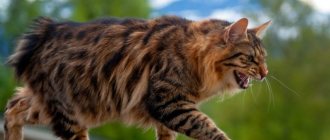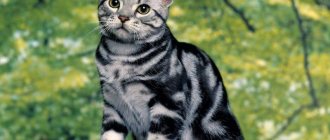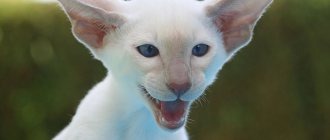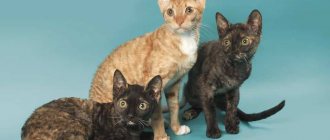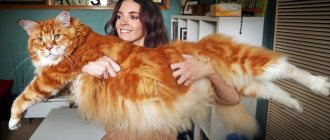Cats are the most popular pets. Therefore, breeders have worked hard and brought out many different breeds. Among them there are both giant animals and the most miniature ones, more like kittens. They are in demand among breeders all over the world.
Cats have long been no longer considered as a tool in the fight against rodents. In recent decades, the activities of breeders have been aimed at breeding ornamental breeds with an unusual appearance. Due to the fact that people have become fashionable for miniature pets, many dwarf cat breeds have been bred.
The vast majority of small cats were created through gene mutation and hybridization. Therefore, these breeds have certain disadvantages. The main ones:
- Limited gene pool.
- Little knowledge of hereditary pathologies.
- Instability of the species.
Despite this, representatives of dwarf cat breeds have a number of advantages:
- Unusual appearance.
- Such animals are distinguished by a calm disposition, kindness, and easy character. They very rarely show aggression or hostility.
- As a result of numerous studies, it has been proven that miniature cats help their owners cope with mental problems.
We present a rating of the 10 smallest cat breeds, whose weight does not exceed 4 kg.
Rating:
- Skif-tay-don
- Skookum
- Munchkin
- Singaporean
- Dwelf
- Minskin
- Kinkaloe
- Bambino
- Napoleon
- Lemkin
In fifth place is a breed called Dwelf.
To create this breed, breeders worked hard and crossed the Munchkin, the Canadian Sphynx and the American Curl. As a result of mating, the result was a rather cute hairless kitten with short legs. Keeping a cat of this breed is not difficult, but you need to remember that by inheritance from three different breeds, the Dwelf has a stubborn character. Therefore, a cat must be raised correctly from an early age. Adults of this breed weigh from 1.8 to 3 kg.
Lembkin
Lembkin translates to "lamb" in English and is the word that best describes this breed. Miniature cats with curly hair, like a sheep's, will not leave anyone indifferent.
In addition to their fur, lambkins are distinguished by short legs, like munchkins. They weigh no more than 3-4 kg, and their color is not strictly defined. This breed cannot be called established; not all kittens from the litter still inherit the desired characteristics, and scientists continue to work on selection.
World “mini-record holders” in the cat family
The record holder for the smallest cat to this day is Mr. Pibbles, a smooth-haired tabby cat with white paws and toes. The body length is only 15 cm, weight is 1.5 kg, and it does not even reach a decimeter in height. Even in infancy, his growth stopped (presumably due to irreversible genetic changes).
The second example is Tinker Toy, a cross between a Himalayan and a Persian cat. At the withers, height is 7 cm, body length is 19 cm, and weight is 700 grams. This miracle of nature comes from Illinois (USA).
Another famous mini-cat is Heed. He lives in San Diego (California, USA), and stopped growing at 3.5 months. Its height at the withers is 8 cm, and its weight is about 900 grams. The reason for this development is genetic predisposition.
The list of small cats should be diluted with a kitty. This is Fizz Girl (Fizz Girl) of the Munchkin breed. According to her breed, she has short paws, and Fizz Gel’s paws are so small that the cat’s height is just over 15 cm.
It may seem that nature has “deprived” the cats mentioned in our ratings. However, this does not prevent wild breeds from getting their own food, and domestic ones from easily jumping onto the windowsill and doing other cat pranks...
Parting words for future owners
If you decide to get yourself dwarf cats, then remember that the modest size of cats does not mean that they do not need to be looked after.
Here is a short list of procedures that even the smallest cats need.
Procedures:
- Clean your tear ducts regularly to prevent infection.
- Worm your pet
- Give crackers and chewing bones, brush your teeth so that there is no tartar
- Maintain a more or less balanced diet
- If your cat has long fur, be sure to brush it at least twice a week.
- Dress in winter cold, and in summer protect from prolonged exposure to the sun
- Visit your veterinarian regularly. Dwarf cats, due to mixing genes, may have weakened immunity and a predisposition to disease.
Following these simple rules will allow you to avoid many problems and enjoy the company of your pet for many, many years.
Singapore
Singapura is a small graceful cat with a clearly oriental appearance. It originated from street cats living in Asia, and more precisely, in Singapore. Hence the name.
For the first time outside the country, such yard cats became known in the USA, and this happened only in the 20th century. The Americans liked the exotic appearance of these cats so much that they decided to breed them. Singapuras weigh only 2-3 kg, they have a small muscular body, convex chest and rounded legs.
But the main feature of the breed is its color. It's called sepia agouti and looks like brown stripes on the base color of ivory. It is the color that judges pay the most attention to at shows, and its description in the passport takes up the most space. In Singapore, these cats are recognized as a national treasure.
The smallest cat breeds. Top 10 (with photos)
9th place. Bambino (the name from the Italian bambino - child) is a short-legged breed of cats without hair, bred in the USA by crossing short-legged Munchkins and hairless Canadian Sphynxes. Average body weight is from 2.2 to 4 kg.
8th place. Lambkin / Lemkin / Lamkin (the name in English is written lambkin and translates as “lamb”) is a breed of cats bred by combining munchkins and the Selkirk Rex breed, characterized by curly hair. The average body weight of lambkins is from 1.8 to 4 kg.
7th place. The Munchkin is a short-legged cat breed, the feline equivalent of the dachshund. Munchkins were not artificially bred, but arose as a result of a natural mutation in the 40s of the 20th century; unusually short-legged and at the same time healthy cats were born in the USA, Great Britain, and they were also seen in Stalingrad. The Americans named the breed Munchkins in honor of the little people in the Magic Land of Oz in the book of the same name by Frank Baum. In the Russian retelling of Alexander Volkov's "The Wizard of the Emerald City" they are called "munchines". On average, munchkin cats weigh between 2.7 and 4 kg, while male cats weigh between 1.8 and 3.6 kg. In 2014, an American munchkin named Liliput, 13.34 cm tall, was recognized as the shortest cat in the world and included in the Guinness Book of Records .
6th place. The Skookum is a cat breed created by combining the Munchkin and the LaPerm breed, which is characterized by long, wavy hair. The average body weight of cats of this breed is from 2.2 to 4 kg, of cats - from 1.8 to 3.6 kg.
5th place. Dwelf is a hairless cat obtained by crossing a Munchkin, a Canadian Sphynx and an American Curl. Body weight from 1.8 to 3 kg.
4th place. The Singapore cat (Singapura) is a breed of short-haired cat that originates from stray cats in the city-state of Singapore. In the 70s, the breed came to the USA, and in the 80s it ended up in Europe, but has not yet become widespread there. An adult Singapura cat weighs on average up to 2 kilograms, a male cat weighs from 2.5 to 3 kilograms.
3rd place. The Minskin is another hairless dwarf cat breed, developed in the United States by crossing Munchkins and hairless Sphynx cats. Average height is 19 cm, average body weight is from 1.8 to 2.7 kg.
2nd place. The Kinkalow is a cat breed created by crossing Munchkins and American Curls. So far there are only a few dozen representatives of this breed in the world. In Russia, one of the Moscow nurseries is engaged in breeding kinkalow. The average body weight of Kinkalow cats is from 2.2 to 3.1 kg, and that of male cats is from 1.3 to 2.2 kg.
The smallest breed of domestic cat is the Scythian-tay-don (another name is the Scythian-toy-bob ). Adult representatives of this breed weigh from 900 grams to 2.5 kg, i.e. no larger than a three to four month old kitten of an ordinary domestic cat. Cats of this breed have a short but strong body and well-developed muscles, a short (3-7 cm) straight or spiral-rounded tail. The hind legs are longer than the front ones.
The history of the appearance of this breed is as follows: in 1983 in Rostov-on-Don, the breeder of Thai (Mekong) bobtails, Elena Krasnichenko, picked up a Thai (Old Siamese type) cat on the street, which she named Mishka. Mishka had four kinks on his tail. And in the winter of 1985, a Thai cat, Sima, with a non-standard short donut tail, appeared in Elena’s house. In 1988, one strange kitten was discovered in the litter of this couple, distinguished from the very beginning by its miniature size and short tail. He received the nickname Kutsy and became the founder of a new breed. And already in 1994, the preliminary standard of the new Scythian-Tai-Don breed was approved at a seminar of WCF felinologists from Russia and the CIS on aboriginal cat breeds in Russia. Initially, the breed was called Scythian-tay-toy-don, reflecting the origin and characteristics of the breed. “Scythian” - for its appearance on the lands once inhabited by Scythians, “tai” - for its appearance, reminiscent of a Thai cat, “toy” - for its “toy” size (English toy - toy), “don” - after the name of the river , on which the city that became the birthplace of the breed is located. The international name of the breed is toybob , i.e. toy bobtail. Those wishing to buy kittens of this unique breed can contact nurseries for breeding Scythian Tay-Dons, which are located in Moscow and Yekaterinburg.
see also The largest breeds of domestic cats
Content Features and Issues
Each dwarf breed has its own specific requirements for keeping the animal, and they should definitely be taken into account if you want your pet to be healthy, active and happy for your whole family for a long time.
Nutrition
High-quality food and proper nutrition are especially important for representatives of dwarf breeds. The diet should be energy-rich and balanced - choose proven ready-made food for active animals.
The best diet options will be suggested by a breeder who has experience and his own observations in a particular breed. When feeding natural food, also consult the experience of the breeder - you are unlikely to be able to correctly create a balanced menu for your pet on your own.
A balanced diet is very important for dwarf cats
Please note: overfeeding is dangerous for most dwarf cats, especially if they do not receive enough exercise. To avoid digestive problems, feed the animal in small portions, two to three times a day. If a Minik has health problems, you will need to consult a veterinarian when creating an optimal individual diet.
Veterinary
Unfortunately, toy breeds are characterized by many genetic diseases and problems with the musculoskeletal system. The risks of pathologies are especially high in very young, not fully formed breeds. Deformations of the spine and chest create big problems - for example, the so-called pectus excavatum.
Pathologies, unfortunately, are unpredictable and can develop at any age. The high demand for feline midgets creates the risk of giving birth to sick animals, which, in fact, is what the world animal protection community is so actively protesting against.
Health is the most important thing for a miniature cat
The process of creating dwarf breeds is very difficult, but it is going on, and its key issues lie in the sphere of responsibility and professionalism of the breeders. Responsibility must prevail over the commercial component of breeding work - only in this case can a healthy and promising population be obtained for the further development of new and really very interesting mini-breeds of cats.
Breeding
Breeding work with dwarf breeds requires serious theoretical training and extensive practical experience. It is very important to choose the right parental pair, not burdened by inbred origin and poor heredity. And with a limited gene pool of rare breeds, selecting worthy sires can become a huge problem.
It is strictly forbidden to allow “superminiks”—animals smaller than the minimum size—for breeding. The result of such careless matings can be not only non-viable offspring, but also serious damage to the cat’s health, even death.
Breeding dwarf breeds is a difficult and responsible process
Considering all the risks for specific animals and the breed as a whole, it is better to leave breeding work to an experienced breeder or engage in breeding under his strict control.
Video: the smallest cat breeds
Napoleon – 4 kg
This munchkin/longhaired Persian mix was officially registered in 1995. Within the breed, cats are divided into two types - the classic Napoleon and the dwarf Napoleon. They differ from each other only in the length of their paws.
Small size, soft character, playfulness and a cute round face make the cat look like a small kitten throughout its life. They have a very thick and beautiful coat with many different colors.
Kinkaloe
Kinkaloo is a small fluffy cat with curved ears, like those of Dwelfs. Not surprising, because they come from the same breed - American Curls. Representatives of the second breed, munchkins and kinkalows, inherited short legs and a good-natured disposition.
Kinkaloo is recognized as an experimental breed; a lot of breeding work is carried out so that the offspring consistently inherit the desired traits, and the cats themselves remain very rare and cost a lot of money.
Seventh place - munchkin
This cat breed was the result of a natural mutation. The main feature of cats is their short legs. Due to their appearance, animals of this breed are original and cute. The short legs of the munchkins did their job, and this breed is incredibly popular and in demand. In 2014, the American Munchkin received the status of the shortest cat in the world and was included in the Guinness Book of Records. The cat's height was only 13.34 cm. Adults of this breed weigh up to 4 kg.
Skookum
The breed of the smallest cat, despite its dwarf size, does not necessarily have to have a fragile, miniature body.
She may have strong and well-developed muscles.
This statement is true for the Skookum breed, which translated into Russian means “unbending.”
The history of Skookums begins in 1996, when the first descendants of crossed Munchkins and La Perms appeared.
Their creator is the American breeder Roy Galusha, who for a decade has been trying to breed a small breed with wavy hair.
Skookum
Even in the photo it is noticeable that representatives of Skookum have a strong body, with well-developed muscles.
Interesting fact! Because of their curly fur, Skookums are also called “dwarf la-perm.”
In 2006, TICA recognized the breed as experimental.
In Australia, Skookum has already been able to win the WNCA champion title.
The weight of dwarf fluffies varies from 2 to 4 kg.
Toy bob
The full name of the breed is Scythian-toy-bob , and its representatives look like miniature cats with a short tail and a color similar to Siamese cats. Today, some federations allow other colors, but this is how the breed was originally conceived, bred and described.
This is the smallest cat in the world, its weight ranges from 1.5-2 kg, while official descriptions indicate that the weight should not exceed 2 kg. According to breeders, toy beans are very affectionate and devoted animals, they are good companions and loyal to humans.
1 0
Ninth place - bambino
Animals of this breed are short-legged hairless cats. They were the result of mating a short-legged munchkin and a Canadian Sphynx. This breed was bred in the USA, and the animals weigh 2.2 - 4 kg. Keeping a bambino is quite simple; you just need to remember that hairless cats often get sick. Therefore, in winter, if the apartment is too cold, dress your pet. This is not only good for his health, but also very stylish.
American Curl, weight up to 4.5 kg
The ancestor of all these cute and friendly cats was the stray cat Shulamith, in whose litter a genetic mutation occurred. After only 2 years, specialists began to specially breed curls as a variety. And after 3 - they were recognized as a separate breed.
These animals are distinguished from other cats by the tips of their ears that are bent back and their light weight - a maximum of 4.5 kg in a female. Curls come in both long-haired and short-haired varieties. The first ones have ears ending in tufts, long, like those of a lynx. The wool is soft and silky, the color can be any.
Minskin
The Minskin is a miniature cat, whose distinctive features are short legs, silky skin and short, dense hair on certain parts of the body. The development of the breed began in 1998, when breeders took munchkins as a basis and crossed them with other breeds to obtain the desired coat.
Despite the fact that the new cat species has been officially registered, work to consolidate the characteristics of the experimental breed is still underway. The cats turned out to be very agile and fast, despite their short legs. They cannot jump high, but thanks to their agility they can climb to the desired height in other ways.
These are mostly healthy cats that love an active lifestyle, are very affectionate and need constant human attention.




